for local areas and regions, but their potential economic significance
is only now being understood by area developers, corporate site seekers
and urban planners. Like never before, airports are central to businesses’
ability to compete given the heightened role of logistics and distribution
in meeting customer and shareholder expectations. Their importance in
this respect cannot be overstated.
 |
| Dr. John D. Kasarda
The Kenan Institute of Private Enterprise |
“Airports will be as important to business location
and urban development in the 21st century as automobiles and trucks
were in the 20th century, railroads were in the 19th century and seaports
were in the 18th century,” says Dr. John D. Kasarda, a leading
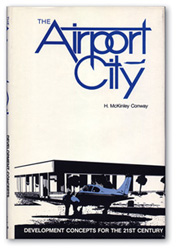 |
expert on airport-centric development. Kasarda is the Kenan Distinguished
Professor of Management and Director of the Kenan Institute of Private
Enterprise at the Kenan-Flagler Business School at the University of
North Carolina at Chapel Hill.
Evidence of airports’ heightened importance in
global commerce and economic development can be seen in Memphis, Tenn.’s
emergence as a world class center of logistics and distribution and
Louisville, Ky., too, thanks to the Federal Express and UPS operations
in those cities respectively. Countless e-commerce companies have established
facilities at or near those cities’ airports, enabling them to offer
next-day — even same-day –delivery of time-sensitive goods. Such “airport
cities” can be found in locations around the world wherever major passenger
and air cargo hubs have attracted significant development. But a newly
emerging phenomenon could make these hubs pale in comparison.
“Substantial evidence is accumulating that major
airports are generating concentrations of commercial activities that
are leading to a new, aviation-linked urban form — the aerotropolis,”
says Kasarda, who consults with airport authorities worldwide on logistics
and air transportation infrastructure. “Planners and developers who
design and build infrastructure and facilities that are consistent with
the new form and function of the aerotropolis can contribute substantially
to the economic competitiveness of urban areas and to the emerging needs
of business.”
Today’s economy is increasingly based on supply-chain-linked
business processes, such as just-in-time and custom manufacturing, and
the global shipment of goods that Kasarda describes as “small, light,
compact and high value to weight.” These include microelectronics, pharmaceuticals,
digitized auto parts, medical instruments and perishables. Air cargo
and air logistics are making it possible for companies to compete globally
and to compete efficiently by delivering product components to manufacturers
or finished products to customers when or before they are expected.
Even if customers can wait, they won’t wait in many cases.
“Logistics has become the major factor in gaining
competitive advantage for most firms because today speed and agility
are as important as price and quality for manufacturers and other goods
producers to compete,” argues Kasarda. “Logistics is now core to the
bottom line profits of organizations. It is no longer viewed as a support
function whose costs are to be minimized, but rather a core function
whose value-adding benefits need to optimized.”
The difference between an airport city and an aerotropolis
lies in the latter’s resemblance to an actual metropolis, or urban area.
The airport and surrounding hotels, retail, distribution centers, light
industrial parks and so forth serve as the central business district,
employing dozens of thousands of workers. In the case of an aerotropolis,
development can extend 10, even 20 miles (16-32 km.) or more away from
the center, incorporating additional development, such as office and
research parks, districts zoned for specific purposes, foreign trade
zones, entertainment and conference facilities and even residential
developments — all of which is anchored by the airport city.
Although the concept is still new, aerotropolis
projects already exist or are under way around the world at both existing
airports or airport cities (Denver International, Hong Kong International,
Seoul Incheon, Paris Charles de Gaulle and Ontario, Calif.) and those
now in planning and development (Suvarnabhumi in Bangkok and the expansion
of Beijing’s Capital International Airport).
Amsterdam Schiphol Airport, employing 58,000 people,
is perhaps the closest thing to a mature aerotropolis there is. Besides
being a major international passenger and cargo facility, it features
intermodal transportation, including rail service to downtown Amsterdam
and to all major cities in Western Europe.
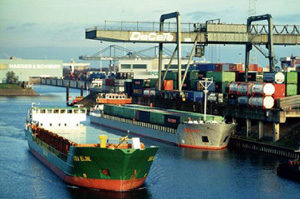 |
|
The Port of Duisburg, located at the Source: Duisport Photo: Felden
|
Retail is a substantial component of the facility’s
economic output, with pre- security-screening shopping available on
weekends when other stores in the area are closed. Major logistics centers
and flower marts are located at Schiphol, as are corporate headquarters
and other business centers. Outside the airport city via two motorways
are numerous logistics parks, office parks, merchandise marts and hotel
and entertainment complexes.
Bigger In Texas
One of the clearest examples of an aerotropolis
taking shape in the U.S. is the one anchored by Dallas-Ft. Worth (DFW)
International Airport, which by itself takes up 18,000 acres (7,300
hectares).
Significant development is under way in Euless, on the
southwest side of DFW, and to the east in Irving — particularly at
Las Colinas, a major development on I-35 on the way into Dallas. Las
Colinas is a 12,000-acre (4,800-hectare) development with 21.2 million
sq. ft. (2 million sq. m.) of office space, 8.5 million sq. ft. (790,000
sq. m.) of light industrial space, 1.3 million sq. ft. (121,000 sq.
m.) of retail, more than 13,000 single and multi-family homes, more
than 3,700 hotel rooms and more than 75 restaurants.
But that’s not all. Just east of Las Colinas is
Dallas Love Field, the original airport serving Dallas and the home
base of Southwest Airlines. Development of the entire I-35 corridor
between DFW and Dallas is booming (much like the growth that has been
taking place on the corridor between Dulles International Airport in
northern Virginia west of Washington, D.C., and the capital).
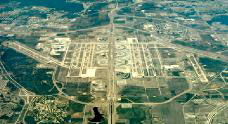 |
| Property development outside of aviation is a major component of airport expansion projects at Dallas-Ft. Worth International Airport and many others throughout the world. |
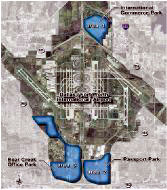
|
Infomart and Market Center are two major merchandise
marts on the corridor that draw hundreds of thousands of exhibitors
and visitors to the area from around the world. North of Fort Worth
is the Alliance Airport cargo and logistics complex, which serves as
a sub-hub to the DFW-based aerotropolis.
Several other U.S. airports are giving commercial,
non-aviation related activities a high priority in their development
planning. These include the airports in Denver, Colo.; Detroit, Mich.;
Las Vegas, Nev.; Minneapolis-St. Paul, Minn.; New York (JFK); and Pittsburgh,
Pa.
Internationally — besides the airports already
mentioned — such planning is under way at Frankfurt Main in Germany,
Barcelona International, Dubai International, Helsinki Ventaa, Singapore
Changi, Stockholm Arlanda, Milan Milpensa and others.
“This leads to a very interesting development that
is just now being recognized in the siting and location fields,” says
Kasarda. “As the airport area develops as a brand — locate at O’Hare
or around DFW — it is attracting businesses to be a part of that brand.
Airports now have image, which is serving as a magnet. Even though companies
locating there may not be directly facilitating movement of passengers
or cargo, being located in the airport city or aerotropolis involves
branding.”
The effect will likely be an increase in the value
of property falling under the brand’s domain, assuming a growing economy
and a continuing increase in the volume of world trade and related demand
for transportation and logistics services.
The increasingly critical role of logistics, too,
is driving up airport site values, which is why AMB Property Corp.,
a San Francisco-based real estate investment trust, recently acquired
the 3.4 million sq. ft. (315,860-sq. m.) portfolio of 37 airfreight
buildings of International Airport Centers. The properties are located
at seven international airports in the U.S. where air cargo activity
is expected to remain strong, including JFK in New York, Los Angeles
International and Seattle-Tacoma International.
“The way companies do business today, they need
every edge they can get, and logistics is part of that,” says Steve
Lueck, AMB’s vice president and asset manager, airport facilities. “You
can have the best product, the best R&D and the best marketing, but
if you can’t get your product to the user through the
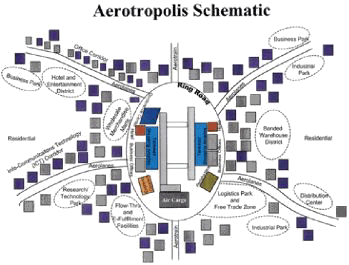 |
| The Kenan Institute of Private Enterprise |
supply chain efficiently, you will lose. So logistics is a key part
of the process, which is behind the emergence of the third-party logistics
providers, who are among our largest customers. They are a value link
in the supply chain, providing more than a way to get a box from here
to there. They provide the efficiency that everyone is looking for,
and we are benefiting from that.”
Global Trade Fueling Seaport Projects
Logistics, transportation and related infrastructure
certainly have an impact on seaport location too. Take Tower Automotive’s
recent decision to locate a new pressed parts plant at the Kablerfeld
Logistic Park in Duisburg, Germany. The Port of Duisburg, located at
the confluence of the Ruhr and Rhine rivers, is Europe’s largest inland
port. Tower will invest $18.4 million in the facility, which will supply
Mercedes-Benz factories in Dusseldorf to the south and Ludwigsfelde
far to the east, just south of Berlin.
In the competitive world of global shipping, size
matters too, as ship capacities test port capacities in turn.
In July 2004, Samsung Heavy Industries, the South
Korean heavyweight in container ship building, delivered the world’s
largest container carrier to Seaspan, the largest Canadian marine carrier.
The 8,500-TEU (twenty-foot equivalent unit, the international standard
measure for containers) super carrier measures 334 m. (1,096 ft.) in
length and nearly 43 m. (141 ft.) across. Taking eight months to design
and another eight months to build, the colossal ship was put into service
immediately on Far East and American routes.
The new ship breaks Samsung’s previous world record
for the largest container ship, but its vessels will only get larger
in coming years. The company is developing a 10,000-TEU ship and is
also designing a 12,000-TEU container carrier.
Increased global trade and larger ships are prompting
expansion projects at ports around the world. The increasing size of
container ships requires channels beyond the current depths of most
U.S. ports, says Kurt Nagle, president and CEO of
 |
| Steve Lueck |
the American Association of Port Authorities (AAPA). Only a few ports
on the West Coast, such as Los Angeles and Long Beach, have channels
deep enough to accommodate the behemoths.
“There are needs at most facilities to deepen at
least areas of the port to handle that size vessel,” Nagle says.
As more large vessels are deployed and accommodated
by larger, deeper ports, Nagle says there will likely be a shifting
of the smaller ships to other ports. So, not every port will need to
deepen its channels to the 52- to 53-ft. (16-m.) level, he says.
Nagle says infrastructure improvements have historically
been ranked by AAPA’s members as the biggest challenge facing the industry.
Now, security needs at ports are competing for limited dollars.
“While infrastructure continues to be a major challenge,
it has been supplanted by security needs and the inherent costs in that,”
Nagle says. “The limited funding of public ports is being shifted to
security needs and making infrastructure improvements more problematic.
There is a legitimate concern over finding funding for both.”
The need for infrastructure improvements is acute
as projections call for shipping trade to double between now and 2020,
Nagle says. The pace of growth is likely to be quicker on the West Coast
as China and other Asian countries continue to pour goods into the U.S.
The Port of Tacoma, Wash., already ranks as one
of the nation’s leading cargo entries, handling more than 1.7 million
TEUs in 2003. A new terminal set for completion in October 2004 will
add capacity for 840,000 containers.
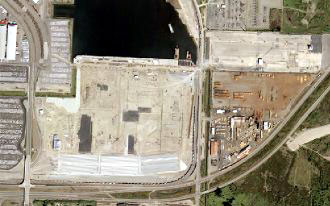 |
| The Port of Tacoma is in the midst of a five-year, $341-million expansion that will see it greatly increase its container capacity. |
The terminal, which will serve Evergreen Marine Corp., a Taiwan-based
container shipper, will be the largest single container terminal north
of Los Angeles. A planned second phase will add capacity for about 400,000
more containers.
Also part of the port’s $341-million, five-year,
capital improvement program is the Marshall Avenue Auto Terminal,
which opened in 2003. The $40-million auto-processing facility allows
the port’s customer, Auto Warehousing Company (AWC) to continue expansion
of auto imports.
From Down Under
Proposed and planned projects in Australia and
New Zealand include major efforts to enlarge channels to accommodate
larger container ships.
The Port of Melbourne Corporation (PoMC) is proposing
a AU$400 million (US$280 million) project to deepen the main commercial
shipping channels to the port to allow the larger container ships to
enter. The current depth means more than 30 percent of container vessels
entering and leaving the port cannot load to full capacity. PoMC has
released an environmental effects statement, and the project is pending
final government approval.
The Port of Melbourne handles AU$70 billion (US$48.9
billion) of trade annually and directly and indirectly employs about
80,000. It is planning an AU$80 million (US$56 million) development
at Victoria Dock to transform a vacant site into a cargo terminal.
The project will create about 300 jobs when the terminal becomes operational
in 2008.
Westgate Ports Pty. Ltd. will develop the terminal
and plans to move at least 50 percent of freight in and out of the
terminal by rail. The company also plans to develop an inland port
linked to the new dock by existing rail infrastructure. The Victoria
Dock development will also include general warehousing facilities.
“The port is vital to our farmers, and to regional
Victorians,” said Peter Batchelor, Victoria’s minister for transport.
“It handles 85 percent of the nation’s dairy exports, 67 percent of
our wool exports and 65 percent of Australia’s rice exports.”
 |
| Auckland, New Zealand, is deepening the commercial shipping lane into its port and boosting container capacity. |
Up Australia’s east coast, the Port of Brisbane
has embarked on a AU$90 million (US$63 million) project to reclaim 230
hectares (568 acres) of land from the sea. The reclamation will involve
building a 4.5-km. (2.8-mile) seawall and filling the enclosed area
over approximately 20 years using material from maintenance dredging.
Government officials estimate the new land might generate more than
1,800 jobs as industry expands into the area.
Across the Tasman Sea from Brisbane and Melbourne,
the Ports of Auckland is in the midst of a NZ$55 million (US$34.5 million)
project to deepen the commercial shipping lane into New Zealand’s largest
container terminal, operated by Axis Fergusson. The first phase of the
reclamation project will allow space for an additional 100,000 containers
annually and will be completed within three years.
Activity related to the Ports of Auckland supports
more than 173,000 jobs in the region, according to Geoff Vazey, Ports
of Auckland chief executive.
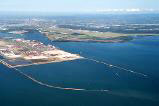 |
| The Port of Brisbane, Australia, is reclaiming land from the sea to greatly increase its size. |
Taking Shape
Shanghai is known for its architectural wonders,
but it would be hard to rival the deepwater port project developing
southeast of the city. Shanghai has experienced explosive growth at
its current port in recent years, but its location at the mouth of the
Yangtze is too shallow to accommodate large ships. Despite the constraints,
Shanghai has become the world’s third-busiest container port.
The first phase of the massive Yangshan port project
south of Shanghai continues to move toward a 2005 completion date. The
master plans calls for development of 50 container berths by 2020 at
the port being constructed on the islands of Xiao Yangshan and Da Yangshan
in Hangzhou Bay. Total project cost is estimated at $16 billion to $18
billion.
Connecting the mainland to the new port is the
31.5-km. (19.5-mile) Donghai Bridge, set for completion by the
end of next year.
It seems that no matter what mode, hundreds of
rail, road and bridge projects are hanging in limbo as the U.S. Congress
continues to delay passage of a full-fledged transportation bill. At
press time, Congress had passed a fifth extension of federal transportation
department programs, with negotiations on the long-term bill expected
to resume in September 2004.
But with the help of a flurry of summer 2004 federal
grants, project work goes on, as does the trade those projects are designed
to facilitate. Go no further than Detroit for evidence of infrastructure’s
role as industrial lifeline.
That’s where the Jobs Tunnel — comprising a new
and enlarged rail tunnel to Windsor, Ont., and a new truck route through
the old one — is currently undergoing environmental review. The route
is vital to both the automotive industry and the border economy, as
the Ambassador Bridge over the Detroit River, which sees 10,000 trucks
a day, is bursting at the seams. The US$430-million project recently
received the endorsement of the chairman of the National Association
of Manufacturers, Richard Dauch, who is co-founder, chair and CEO of
American Axle & Manufacturing. And it got the nod from the AFL-CIO.
But the endorsement of everyday people may be just as meaningful, especially
those involved in the industrial trade that transpires on that route.
“I am personally sick and tired of the hours of
waiting in line just to deliver into Ohio,” writes one commercial truck
driver on the Detroit River Tunnel Partnership’s Web site. No doubt
that driver’s clients are, too.
Toward Rail Feasibility
Moving people can be just as crucial to corporate
prospects as moving freight. Several U.S. regions are racing to be the
first to attract federal funding for regional high-speed passenger rail
systems. In the meantime, smaller regions are moving forward with more
concrete plans.
In the Triangle area of North Carolina, Triangle
Transit Authority (TTA) is still going forward with a revised plan for
regional rail transit that will link Durham, Research Triangle Park,
Cary, Raleigh and fast-growing North Raleigh. Final design work began
in 2003 for the $724-million project, and a federal grant of $17.2 million
was awarded in July 2004. But the still-stalled federal transportation
bill has more than 180 other projects around the country anxiously awaiting
funding.
Meanwhile, one of the main funding sources for
the TTA project — a rental car tax in Durham, Orange and Wake counties
— has seen flat revenues since 2001. But the real reason for the revised
scope (from 16 stations to 12, with the remaining four delayed beyond
2011) is that TTA and other agencies around the country have been instructed
by the Federal Transit Administration to remove from their plans lease
options on railcars and other infrastructure property. Such options
would have generated $28 million in revenue for TTA.
Outside the nation’s capital, federal officials
gave the go-ahead in June 2004 for $45 million worth of design work
towards an expansion of the Washington Metro rail system into northern
Virginia. The first phase of the proposed two-phase project would cost
between $1.5 billion and $1.8 billion and extend from West Falls Church
to Reston. The first phase would be half-funded by the federal government,
and 25 percent each from the Commonwealth of Virginia and Fairfax Co.,
Va. Another extension into Maryland received a $32.8-million federal
grant in July 2004.
The Maryland Transit Administration will see the
23-mile (9.3-km.) Central Corridor light rail line continue development
thanks to another July 2004 grant of $23 million from the U.S. Dept.
of Transportation. The line, expected to be complete in 2006, will serve
Baltimore, Baltimore Co. and Anne Arundel Co.
In Chicago, Mayor Richard M. Daley’s Chicago Region
Environmental and Transportation Efficiency (CREATE) regional rail plan
involves an overall upgrade to the area’s rail infrastructure. The six
major freight railroads that serve the Chicago market would contribute
$210 million to the $1.5-billion program.
In addition, plans are moving forward for a $213-million
express transit train route from Chicago’s center city to both O’Hare
and Midway airports. The hub for the service would serve as a check-in
point for airline passengers. While most of the funding would come from
city coffers, around $41 million would come from Mills Corp., a retail
REIT based in Arlington, Va., which wants to develop the property around
the hub station.
Looking east, an update of the 10-year-old Detroit-Chicago
High-Speed Rail Corridor Program Study is under way. The family of projects
would cost $550 million to implement.
Further west, Union Pacific Railroad in June 2004
broke ground on its new Dallas intermodal terminal, jointly located
in the cities of Hutchins and Wilmer, along the UP’s main line between
Dallas and Houston. The facility, in an industrial park developed by
Prime Rail Interest, should be operational in June 2005.
Just to the south, UP is involved in another unique
project: simultaneous development of UP facilities in Cameron County,
Texas, and facilities just across the border in Matamoros, Mexico, belonging
to Transportacion Ferroviarias Mexicana. Kansas City, Mo.-based HNTB
is designing the facilities, which will involve $22 million worth of
relocation railway in Cameron County, a 2,300-ft. (700-m.) tall rail
bridge over the Rio Grande and an arterial roadway. The project is projected
to be completed in late 2005.
Big Vision Up North
In Canada, Ontario’s Ministry of Public Infrastructure
Redevelopment in July 2004 issued a sweeping growth plan for the Greater
Golden Horseshoe region that incorporates plans for roads, transit,
water, sewers, schools and hospitals. Such vision could cost as much
as US$75 billion over the next 30 years.
The Greater Toronto Area (GTA) transportation plan
focuses on two main corridors connected to border business: the GTA-Niagara
corridor and the GTA-Guelph/Kitchener/ Waterloo corridor, including
traffic relief related to Highway 401 and the busy border crossings
at Sarnia and Windsor. The 10-year growth plan for the Golden Horseshoe
considers such fiscal mechanisms and incentives as gas tax revenues,
tax-increment financing, land transfer tax rebates, development charges
and property-tax reform.
In British Columbia, a combination of projects
on the coast and inland is adding up to some US$4.5 billion in road,
tunnel and bridge work over the next decade. The Sea to Sky Highway
upgrade in the Vancouver area is seeing a hefty portion of that investment.
Approaches and a bridge across Okanagan Lake near Kelowna, upgrades
of the Trans-Canada highway and highway corridors to the B.C.-U.S. border
are receiving additional attention and funding.
Receiving just as much attention is the proposed
passenger rail line between Vancouver, its airport and Richmond, B.C.,
with a price tag of US$1.1 billion, and another Lower Mainland transit
line projected to cost $603 million.
And in another infrastructure realm altogether,
B.C., Alberta and Canadian officials and others are mulling Alaska Gov.
Frank Murkowski’s proposed $23.5-billion railway, natural gas pipeline
and highway project.
Continuing to the West, major projects valued in
the billions are under way to link Russia to China via both rail and
road infrastructure, mirroring the pipeline activity already apparent
in the region. On a bigger scale, 32 countries have agreed to an Asian
Highway Network plan, although funding for the 87,000-mile (140,000-km.)
network would total nearly $16 billion. A full 16,000 miles (26,000
km.) of that network would occur in China, and are scheduled to be complete
by 2010.
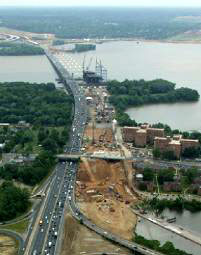 |
| The Woodrow Wilson Bridge south of the Washington, D.C., metro conveys as much as $100 billion worth of commerce annually, according to officials with the bridge’s $2.44-billion rehab project. |
The fast-rising industrial economy of Brazil is
seeing an equally large-scale project, the transformation of its 1,097-mile
(1,765-km.) BR-163 highway from partially unpaved road to superhighway.
While deforestation concerns hover over the project, its completion
would not only smooth agricultural exports (trade negotiations notwithstanding),
but, according to a report in The Economist, reduce annual freight costs
for manufacturers in duty-free Manaus by US$99 million.
Interchange projects are proving as vital as long
stretches of highway. The $290-million Grandview Triangle project in
Kansas City, Mo., designed by HNTB, is ahead of schedule in its rehab
of a major highway tangle that involves some 540 acres (219 hectares)
and one million sq. ft. (9,290 sq. m.) of bridge deck work. When complete
in 2008, the interchange’s capacity will be increased from 250,000 daily
vehicles to 440,000, and the new design has the potential to eliminate
the equivalent of one accident per day.
Other road and interchange programs of note include
an 18-month, $100-million improvement plan around the agricultural and
transit hub of Decatur, Ill., and a new I-65 interchange near the growing
industrial community of Cullman, Ala., which is also on tenterhooks
awaiting federal funding.
Need to Cross Funding Chasm
The Appalachian Development Highway System inches
closer to completion, promising to close the circle of transit and open
up new opportunities for this region. One of the next projects in the
region is the $90-million Blennerhassett Island Bridge near Parkersburg,
W.Va., which will complete a 300-mile (483-km.) highway corridor from
Cincinnati to Bridgeport, W.Va. The ADHS program overall would receive
some $2.7 billion in funding under the Bush administration’s transportation
bill.
Another $90 million is slated for the $234-million
Hoover Dam Bypass bridge project, where work is projected to begin this
fall toward a pushed-back 2008 completion date. Nevada and Arizona officials
in June 2004 authorized the use of Grant Anticipation Revenue Vehicle
(GARVEE) bonds to keep the project moving forward pending federal action.
The current highway that traverses the dam handles 13,000 vehicles a
day, but no trucks since 9/11. Instead, that crucial commercial traffic
has been making a 23-mile (37-km.) detour, passing costs along to industry
and consumers. While work on the span itself is now in the digging phase,
the approaches on either side are well under way, with a cumulative
value of $52.4 million.

But the biggest
project of all may be the Woodrow Wilson bridge rehab in Maryland, Virginia
and the District of Columbia. The bridge itself will cost $600 million
out of an estimated $2.44 billion to be spent on the whole complex of
projects, with $1.63 billion of that total coming from the federal government.
Total work should be winding down by 2008. 